Analysis of Woolworths Operations Management: Quality and Strategy
VerifiedAdded on 2023/04/25
|12
|3803
|346
Report
AI Summary
This report provides a comprehensive analysis of Woolworths' operations management, addressing issues of poor product and service quality. It explores the causes of these issues, including employee performance, inadequate quality control, and supply chain inefficiencies. The report also evaluates Woolworths' low pricing strategy and its impact on perceived quality. Furthermore, it proposes five key strategies for improving product and service quality, including product innovation, effective supply chain management, consumer-based pricing, and robust product quality management. The report emphasizes the importance of these strategies in enhancing Woolworths' brand image, customer satisfaction, and overall operational efficiency. The strategies are supported by relevant literature and examples, providing a practical approach to address the challenges faced by the company. The report aims to provide a detailed overview of the operational challenges and suggests practical solutions to improve the quality of products and services in Woolworths.
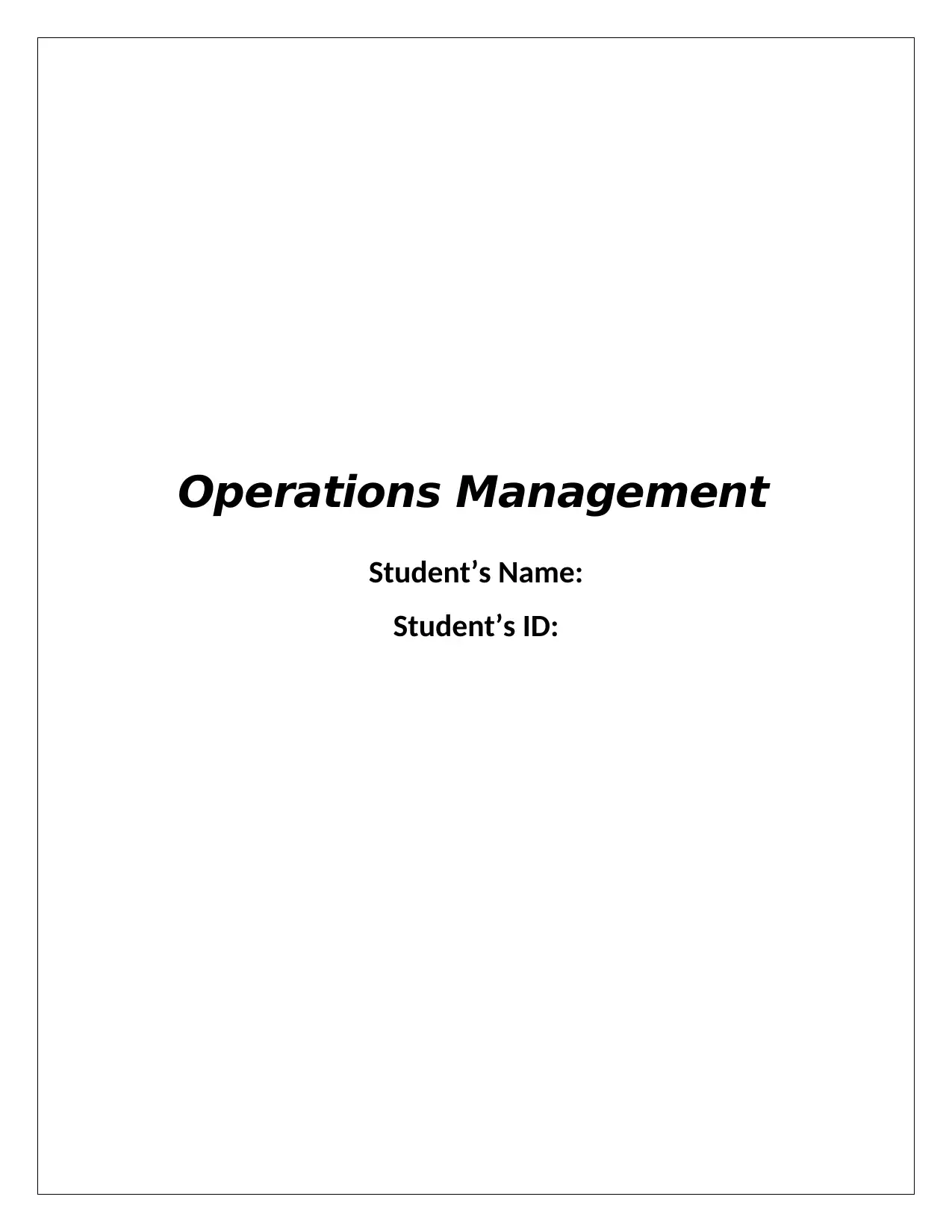
Operations Management
Student’s Name:
Student’s ID:
Student’s Name:
Student’s ID:
Paraphrase This Document
Need a fresh take? Get an instant paraphrase of this document with our AI Paraphraser
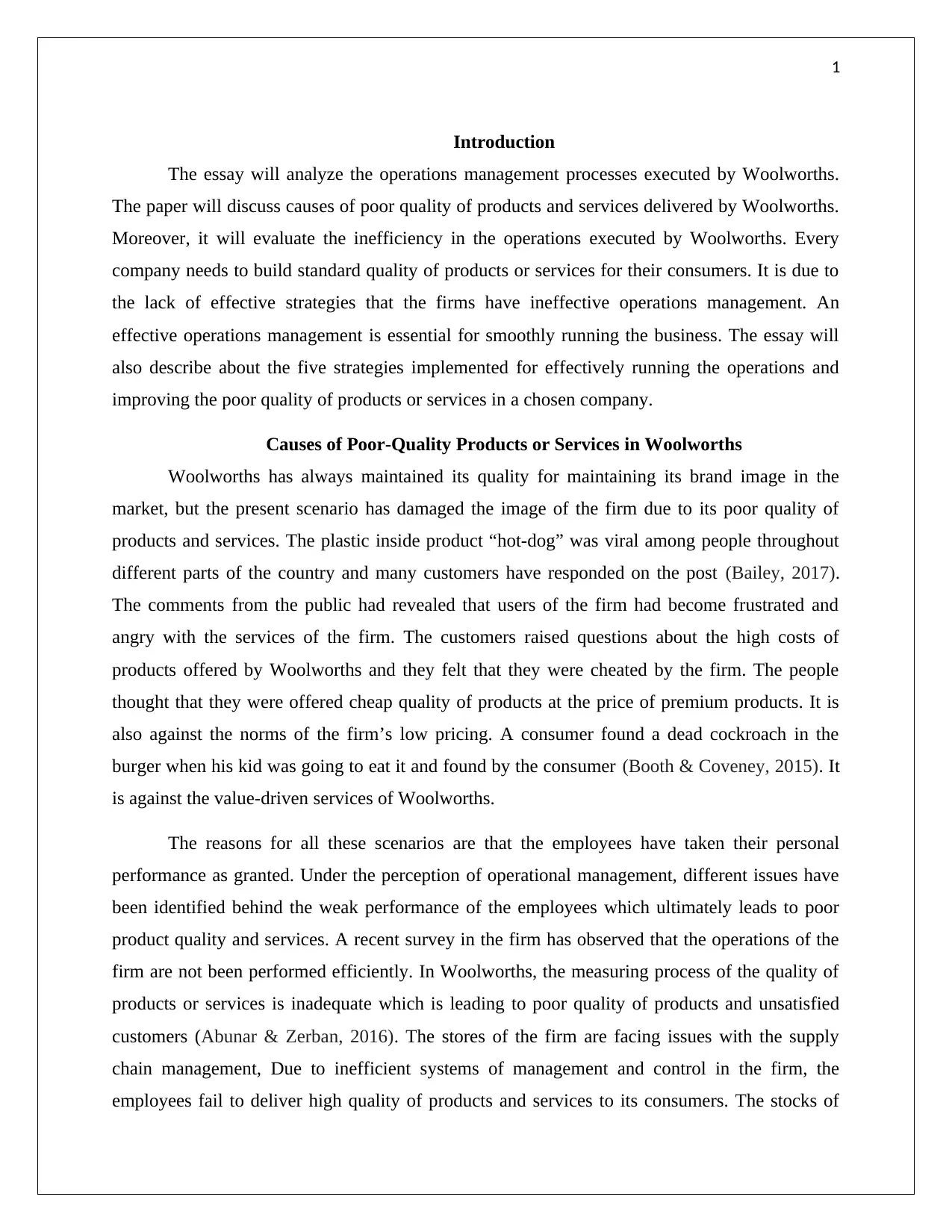
1
Introduction
The essay will analyze the operations management processes executed by Woolworths.
The paper will discuss causes of poor quality of products and services delivered by Woolworths.
Moreover, it will evaluate the inefficiency in the operations executed by Woolworths. Every
company needs to build standard quality of products or services for their consumers. It is due to
the lack of effective strategies that the firms have ineffective operations management. An
effective operations management is essential for smoothly running the business. The essay will
also describe about the five strategies implemented for effectively running the operations and
improving the poor quality of products or services in a chosen company.
Causes of Poor-Quality Products or Services in Woolworths
Woolworths has always maintained its quality for maintaining its brand image in the
market, but the present scenario has damaged the image of the firm due to its poor quality of
products and services. The plastic inside product “hot-dog” was viral among people throughout
different parts of the country and many customers have responded on the post (Bailey, 2017).
The comments from the public had revealed that users of the firm had become frustrated and
angry with the services of the firm. The customers raised questions about the high costs of
products offered by Woolworths and they felt that they were cheated by the firm. The people
thought that they were offered cheap quality of products at the price of premium products. It is
also against the norms of the firm’s low pricing. A consumer found a dead cockroach in the
burger when his kid was going to eat it and found by the consumer (Booth & Coveney, 2015). It
is against the value-driven services of Woolworths.
The reasons for all these scenarios are that the employees have taken their personal
performance as granted. Under the perception of operational management, different issues have
been identified behind the weak performance of the employees which ultimately leads to poor
product quality and services. A recent survey in the firm has observed that the operations of the
firm are not been performed efficiently. In Woolworths, the measuring process of the quality of
products or services is inadequate which is leading to poor quality of products and unsatisfied
customers (Abunar & Zerban, 2016). The stores of the firm are facing issues with the supply
chain management, Due to inefficient systems of management and control in the firm, the
employees fail to deliver high quality of products and services to its consumers. The stocks of
Introduction
The essay will analyze the operations management processes executed by Woolworths.
The paper will discuss causes of poor quality of products and services delivered by Woolworths.
Moreover, it will evaluate the inefficiency in the operations executed by Woolworths. Every
company needs to build standard quality of products or services for their consumers. It is due to
the lack of effective strategies that the firms have ineffective operations management. An
effective operations management is essential for smoothly running the business. The essay will
also describe about the five strategies implemented for effectively running the operations and
improving the poor quality of products or services in a chosen company.
Causes of Poor-Quality Products or Services in Woolworths
Woolworths has always maintained its quality for maintaining its brand image in the
market, but the present scenario has damaged the image of the firm due to its poor quality of
products and services. The plastic inside product “hot-dog” was viral among people throughout
different parts of the country and many customers have responded on the post (Bailey, 2017).
The comments from the public had revealed that users of the firm had become frustrated and
angry with the services of the firm. The customers raised questions about the high costs of
products offered by Woolworths and they felt that they were cheated by the firm. The people
thought that they were offered cheap quality of products at the price of premium products. It is
also against the norms of the firm’s low pricing. A consumer found a dead cockroach in the
burger when his kid was going to eat it and found by the consumer (Booth & Coveney, 2015). It
is against the value-driven services of Woolworths.
The reasons for all these scenarios are that the employees have taken their personal
performance as granted. Under the perception of operational management, different issues have
been identified behind the weak performance of the employees which ultimately leads to poor
product quality and services. A recent survey in the firm has observed that the operations of the
firm are not been performed efficiently. In Woolworths, the measuring process of the quality of
products or services is inadequate which is leading to poor quality of products and unsatisfied
customers (Abunar & Zerban, 2016). The stores of the firm are facing issues with the supply
chain management, Due to inefficient systems of management and control in the firm, the
employees fail to deliver high quality of products and services to its consumers. The stocks of
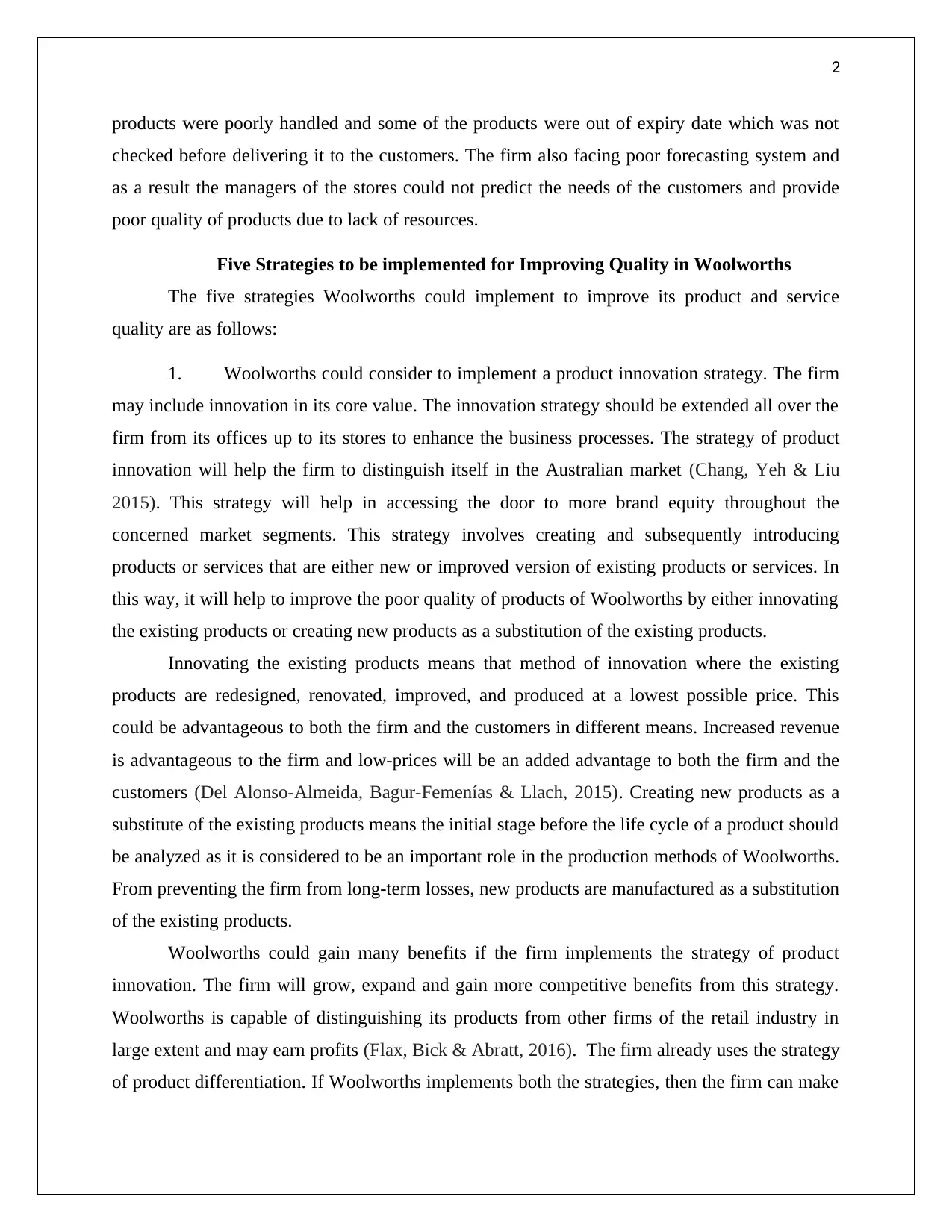
2
products were poorly handled and some of the products were out of expiry date which was not
checked before delivering it to the customers. The firm also facing poor forecasting system and
as a result the managers of the stores could not predict the needs of the customers and provide
poor quality of products due to lack of resources.
Five Strategies to be implemented for Improving Quality in Woolworths
The five strategies Woolworths could implement to improve its product and service
quality are as follows:
1. Woolworths could consider to implement a product innovation strategy. The firm
may include innovation in its core value. The innovation strategy should be extended all over the
firm from its offices up to its stores to enhance the business processes. The strategy of product
innovation will help the firm to distinguish itself in the Australian market (Chang, Yeh & Liu
2015). This strategy will help in accessing the door to more brand equity throughout the
concerned market segments. This strategy involves creating and subsequently introducing
products or services that are either new or improved version of existing products or services. In
this way, it will help to improve the poor quality of products of Woolworths by either innovating
the existing products or creating new products as a substitution of the existing products.
Innovating the existing products means that method of innovation where the existing
products are redesigned, renovated, improved, and produced at a lowest possible price. This
could be advantageous to both the firm and the customers in different means. Increased revenue
is advantageous to the firm and low-prices will be an added advantage to both the firm and the
customers (Del Alonso-Almeida, Bagur-Femenías & Llach, 2015). Creating new products as a
substitute of the existing products means the initial stage before the life cycle of a product should
be analyzed as it is considered to be an important role in the production methods of Woolworths.
From preventing the firm from long-term losses, new products are manufactured as a substitution
of the existing products.
Woolworths could gain many benefits if the firm implements the strategy of product
innovation. The firm will grow, expand and gain more competitive benefits from this strategy.
Woolworths is capable of distinguishing its products from other firms of the retail industry in
large extent and may earn profits (Flax, Bick & Abratt, 2016). The firm already uses the strategy
of product differentiation. If Woolworths implements both the strategies, then the firm can make
products were poorly handled and some of the products were out of expiry date which was not
checked before delivering it to the customers. The firm also facing poor forecasting system and
as a result the managers of the stores could not predict the needs of the customers and provide
poor quality of products due to lack of resources.
Five Strategies to be implemented for Improving Quality in Woolworths
The five strategies Woolworths could implement to improve its product and service
quality are as follows:
1. Woolworths could consider to implement a product innovation strategy. The firm
may include innovation in its core value. The innovation strategy should be extended all over the
firm from its offices up to its stores to enhance the business processes. The strategy of product
innovation will help the firm to distinguish itself in the Australian market (Chang, Yeh & Liu
2015). This strategy will help in accessing the door to more brand equity throughout the
concerned market segments. This strategy involves creating and subsequently introducing
products or services that are either new or improved version of existing products or services. In
this way, it will help to improve the poor quality of products of Woolworths by either innovating
the existing products or creating new products as a substitution of the existing products.
Innovating the existing products means that method of innovation where the existing
products are redesigned, renovated, improved, and produced at a lowest possible price. This
could be advantageous to both the firm and the customers in different means. Increased revenue
is advantageous to the firm and low-prices will be an added advantage to both the firm and the
customers (Del Alonso-Almeida, Bagur-Femenías & Llach, 2015). Creating new products as a
substitute of the existing products means the initial stage before the life cycle of a product should
be analyzed as it is considered to be an important role in the production methods of Woolworths.
From preventing the firm from long-term losses, new products are manufactured as a substitution
of the existing products.
Woolworths could gain many benefits if the firm implements the strategy of product
innovation. The firm will grow, expand and gain more competitive benefits from this strategy.
Woolworths is capable of distinguishing its products from other firms of the retail industry in
large extent and may earn profits (Flax, Bick & Abratt, 2016). The firm already uses the strategy
of product differentiation. If Woolworths implements both the strategies, then the firm can make
⊘ This is a preview!⊘
Do you want full access?
Subscribe today to unlock all pages.

Trusted by 1+ million students worldwide
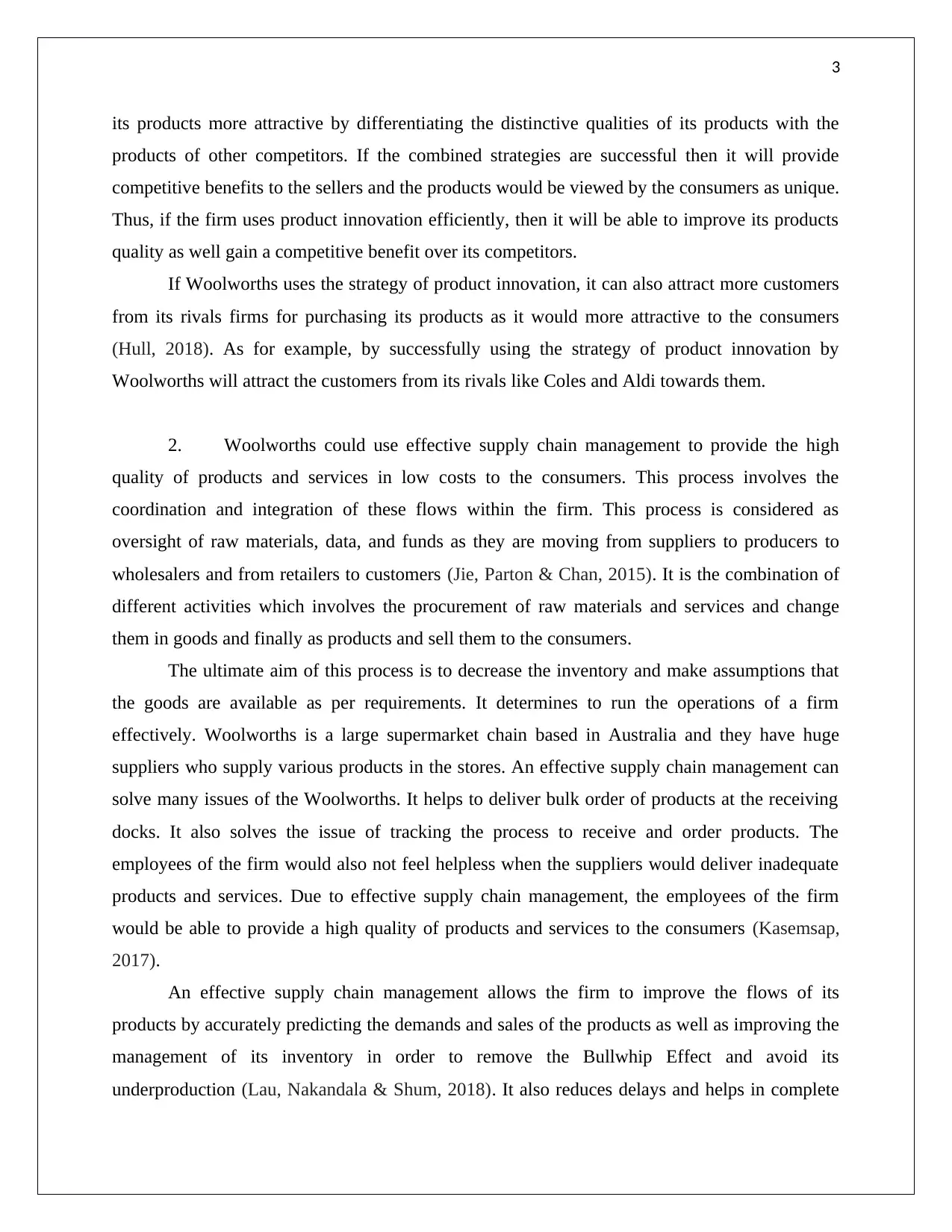
3
its products more attractive by differentiating the distinctive qualities of its products with the
products of other competitors. If the combined strategies are successful then it will provide
competitive benefits to the sellers and the products would be viewed by the consumers as unique.
Thus, if the firm uses product innovation efficiently, then it will be able to improve its products
quality as well gain a competitive benefit over its competitors.
If Woolworths uses the strategy of product innovation, it can also attract more customers
from its rivals firms for purchasing its products as it would more attractive to the consumers
(Hull, 2018). As for example, by successfully using the strategy of product innovation by
Woolworths will attract the customers from its rivals like Coles and Aldi towards them.
2. Woolworths could use effective supply chain management to provide the high
quality of products and services in low costs to the consumers. This process involves the
coordination and integration of these flows within the firm. This process is considered as
oversight of raw materials, data, and funds as they are moving from suppliers to producers to
wholesalers and from retailers to customers (Jie, Parton & Chan, 2015). It is the combination of
different activities which involves the procurement of raw materials and services and change
them in goods and finally as products and sell them to the consumers.
The ultimate aim of this process is to decrease the inventory and make assumptions that
the goods are available as per requirements. It determines to run the operations of a firm
effectively. Woolworths is a large supermarket chain based in Australia and they have huge
suppliers who supply various products in the stores. An effective supply chain management can
solve many issues of the Woolworths. It helps to deliver bulk order of products at the receiving
docks. It also solves the issue of tracking the process to receive and order products. The
employees of the firm would also not feel helpless when the suppliers would deliver inadequate
products and services. Due to effective supply chain management, the employees of the firm
would be able to provide a high quality of products and services to the consumers (Kasemsap,
2017).
An effective supply chain management allows the firm to improve the flows of its
products by accurately predicting the demands and sales of the products as well as improving the
management of its inventory in order to remove the Bullwhip Effect and avoid its
underproduction (Lau, Nakandala & Shum, 2018). It also reduces delays and helps in complete
its products more attractive by differentiating the distinctive qualities of its products with the
products of other competitors. If the combined strategies are successful then it will provide
competitive benefits to the sellers and the products would be viewed by the consumers as unique.
Thus, if the firm uses product innovation efficiently, then it will be able to improve its products
quality as well gain a competitive benefit over its competitors.
If Woolworths uses the strategy of product innovation, it can also attract more customers
from its rivals firms for purchasing its products as it would more attractive to the consumers
(Hull, 2018). As for example, by successfully using the strategy of product innovation by
Woolworths will attract the customers from its rivals like Coles and Aldi towards them.
2. Woolworths could use effective supply chain management to provide the high
quality of products and services in low costs to the consumers. This process involves the
coordination and integration of these flows within the firm. This process is considered as
oversight of raw materials, data, and funds as they are moving from suppliers to producers to
wholesalers and from retailers to customers (Jie, Parton & Chan, 2015). It is the combination of
different activities which involves the procurement of raw materials and services and change
them in goods and finally as products and sell them to the consumers.
The ultimate aim of this process is to decrease the inventory and make assumptions that
the goods are available as per requirements. It determines to run the operations of a firm
effectively. Woolworths is a large supermarket chain based in Australia and they have huge
suppliers who supply various products in the stores. An effective supply chain management can
solve many issues of the Woolworths. It helps to deliver bulk order of products at the receiving
docks. It also solves the issue of tracking the process to receive and order products. The
employees of the firm would also not feel helpless when the suppliers would deliver inadequate
products and services. Due to effective supply chain management, the employees of the firm
would be able to provide a high quality of products and services to the consumers (Kasemsap,
2017).
An effective supply chain management allows the firm to improve the flows of its
products by accurately predicting the demands and sales of the products as well as improving the
management of its inventory in order to remove the Bullwhip Effect and avoid its
underproduction (Lau, Nakandala & Shum, 2018). It also reduces delays and helps in complete
Paraphrase This Document
Need a fresh take? Get an instant paraphrase of this document with our AI Paraphraser
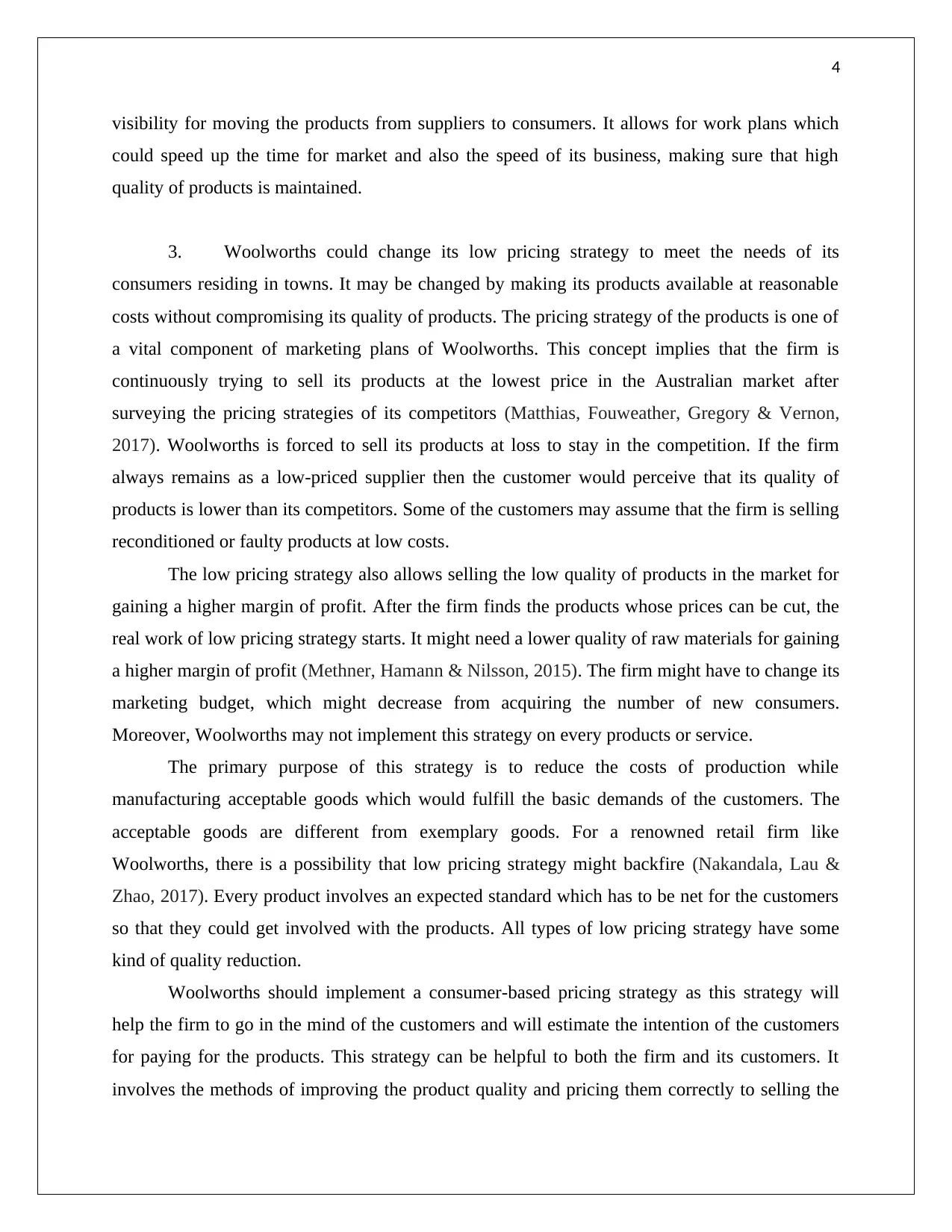
4
visibility for moving the products from suppliers to consumers. It allows for work plans which
could speed up the time for market and also the speed of its business, making sure that high
quality of products is maintained.
3. Woolworths could change its low pricing strategy to meet the needs of its
consumers residing in towns. It may be changed by making its products available at reasonable
costs without compromising its quality of products. The pricing strategy of the products is one of
a vital component of marketing plans of Woolworths. This concept implies that the firm is
continuously trying to sell its products at the lowest price in the Australian market after
surveying the pricing strategies of its competitors (Matthias, Fouweather, Gregory & Vernon,
2017). Woolworths is forced to sell its products at loss to stay in the competition. If the firm
always remains as a low-priced supplier then the customer would perceive that its quality of
products is lower than its competitors. Some of the customers may assume that the firm is selling
reconditioned or faulty products at low costs.
The low pricing strategy also allows selling the low quality of products in the market for
gaining a higher margin of profit. After the firm finds the products whose prices can be cut, the
real work of low pricing strategy starts. It might need a lower quality of raw materials for gaining
a higher margin of profit (Methner, Hamann & Nilsson, 2015). The firm might have to change its
marketing budget, which might decrease from acquiring the number of new consumers.
Moreover, Woolworths may not implement this strategy on every products or service.
The primary purpose of this strategy is to reduce the costs of production while
manufacturing acceptable goods which would fulfill the basic demands of the customers. The
acceptable goods are different from exemplary goods. For a renowned retail firm like
Woolworths, there is a possibility that low pricing strategy might backfire (Nakandala, Lau &
Zhao, 2017). Every product involves an expected standard which has to be net for the customers
so that they could get involved with the products. All types of low pricing strategy have some
kind of quality reduction.
Woolworths should implement a consumer-based pricing strategy as this strategy will
help the firm to go in the mind of the customers and will estimate the intention of the customers
for paying for the products. This strategy can be helpful to both the firm and its customers. It
involves the methods of improving the product quality and pricing them correctly to selling the
visibility for moving the products from suppliers to consumers. It allows for work plans which
could speed up the time for market and also the speed of its business, making sure that high
quality of products is maintained.
3. Woolworths could change its low pricing strategy to meet the needs of its
consumers residing in towns. It may be changed by making its products available at reasonable
costs without compromising its quality of products. The pricing strategy of the products is one of
a vital component of marketing plans of Woolworths. This concept implies that the firm is
continuously trying to sell its products at the lowest price in the Australian market after
surveying the pricing strategies of its competitors (Matthias, Fouweather, Gregory & Vernon,
2017). Woolworths is forced to sell its products at loss to stay in the competition. If the firm
always remains as a low-priced supplier then the customer would perceive that its quality of
products is lower than its competitors. Some of the customers may assume that the firm is selling
reconditioned or faulty products at low costs.
The low pricing strategy also allows selling the low quality of products in the market for
gaining a higher margin of profit. After the firm finds the products whose prices can be cut, the
real work of low pricing strategy starts. It might need a lower quality of raw materials for gaining
a higher margin of profit (Methner, Hamann & Nilsson, 2015). The firm might have to change its
marketing budget, which might decrease from acquiring the number of new consumers.
Moreover, Woolworths may not implement this strategy on every products or service.
The primary purpose of this strategy is to reduce the costs of production while
manufacturing acceptable goods which would fulfill the basic demands of the customers. The
acceptable goods are different from exemplary goods. For a renowned retail firm like
Woolworths, there is a possibility that low pricing strategy might backfire (Nakandala, Lau &
Zhao, 2017). Every product involves an expected standard which has to be net for the customers
so that they could get involved with the products. All types of low pricing strategy have some
kind of quality reduction.
Woolworths should implement a consumer-based pricing strategy as this strategy will
help the firm to go in the mind of the customers and will estimate the intention of the customers
for paying for the products. This strategy can be helpful to both the firm and its customers. It
involves the methods of improving the product quality and pricing them correctly to selling the
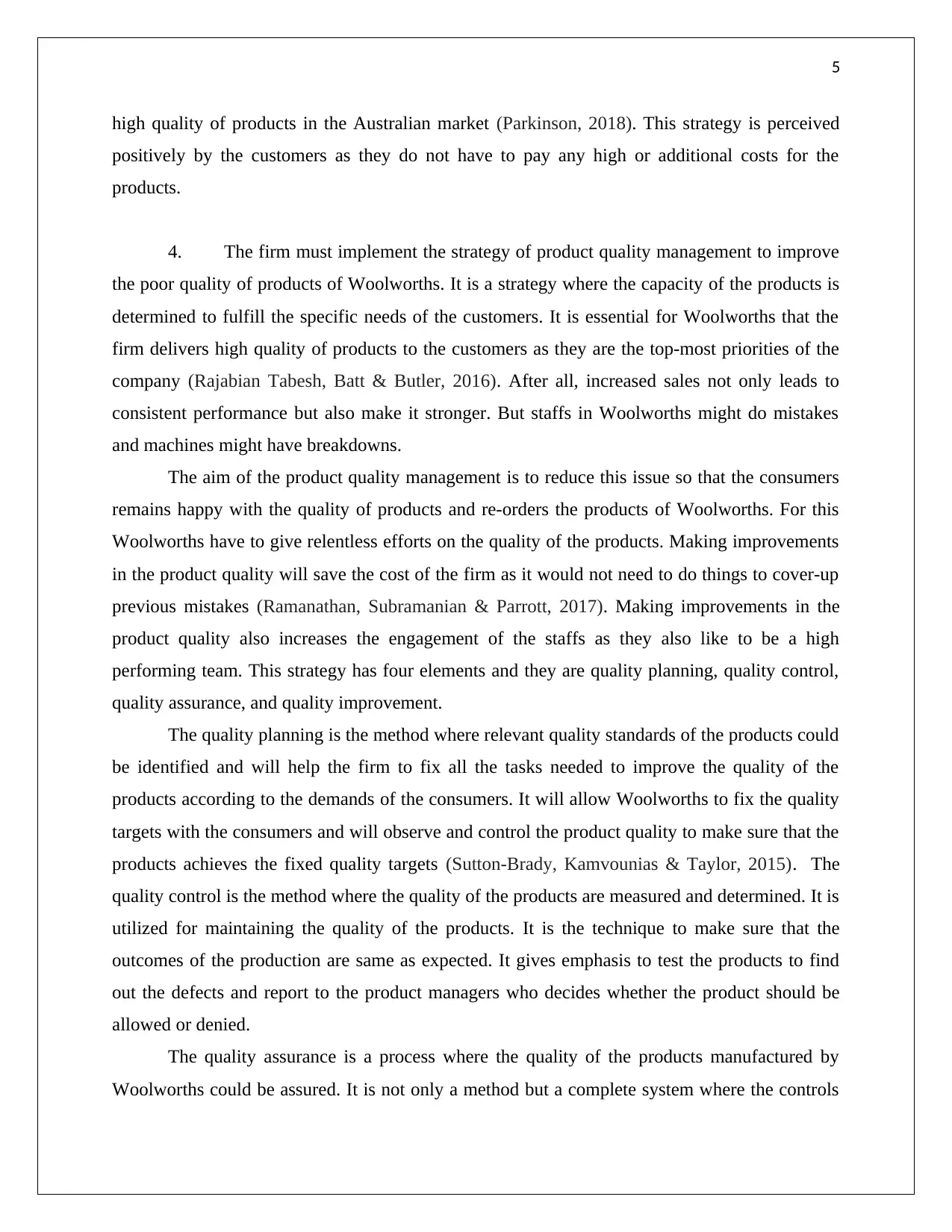
5
high quality of products in the Australian market (Parkinson, 2018). This strategy is perceived
positively by the customers as they do not have to pay any high or additional costs for the
products.
4. The firm must implement the strategy of product quality management to improve
the poor quality of products of Woolworths. It is a strategy where the capacity of the products is
determined to fulfill the specific needs of the customers. It is essential for Woolworths that the
firm delivers high quality of products to the customers as they are the top-most priorities of the
company (Rajabian Tabesh, Batt & Butler, 2016). After all, increased sales not only leads to
consistent performance but also make it stronger. But staffs in Woolworths might do mistakes
and machines might have breakdowns.
The aim of the product quality management is to reduce this issue so that the consumers
remains happy with the quality of products and re-orders the products of Woolworths. For this
Woolworths have to give relentless efforts on the quality of the products. Making improvements
in the product quality will save the cost of the firm as it would not need to do things to cover-up
previous mistakes (Ramanathan, Subramanian & Parrott, 2017). Making improvements in the
product quality also increases the engagement of the staffs as they also like to be a high
performing team. This strategy has four elements and they are quality planning, quality control,
quality assurance, and quality improvement.
The quality planning is the method where relevant quality standards of the products could
be identified and will help the firm to fix all the tasks needed to improve the quality of the
products according to the demands of the consumers. It will allow Woolworths to fix the quality
targets with the consumers and will observe and control the product quality to make sure that the
products achieves the fixed quality targets (Sutton-Brady, Kamvounias & Taylor, 2015). The
quality control is the method where the quality of the products are measured and determined. It is
utilized for maintaining the quality of the products. It is the technique to make sure that the
outcomes of the production are same as expected. It gives emphasis to test the products to find
out the defects and report to the product managers who decides whether the product should be
allowed or denied.
The quality assurance is a process where the quality of the products manufactured by
Woolworths could be assured. It is not only a method but a complete system where the controls
high quality of products in the Australian market (Parkinson, 2018). This strategy is perceived
positively by the customers as they do not have to pay any high or additional costs for the
products.
4. The firm must implement the strategy of product quality management to improve
the poor quality of products of Woolworths. It is a strategy where the capacity of the products is
determined to fulfill the specific needs of the customers. It is essential for Woolworths that the
firm delivers high quality of products to the customers as they are the top-most priorities of the
company (Rajabian Tabesh, Batt & Butler, 2016). After all, increased sales not only leads to
consistent performance but also make it stronger. But staffs in Woolworths might do mistakes
and machines might have breakdowns.
The aim of the product quality management is to reduce this issue so that the consumers
remains happy with the quality of products and re-orders the products of Woolworths. For this
Woolworths have to give relentless efforts on the quality of the products. Making improvements
in the product quality will save the cost of the firm as it would not need to do things to cover-up
previous mistakes (Ramanathan, Subramanian & Parrott, 2017). Making improvements in the
product quality also increases the engagement of the staffs as they also like to be a high
performing team. This strategy has four elements and they are quality planning, quality control,
quality assurance, and quality improvement.
The quality planning is the method where relevant quality standards of the products could
be identified and will help the firm to fix all the tasks needed to improve the quality of the
products according to the demands of the consumers. It will allow Woolworths to fix the quality
targets with the consumers and will observe and control the product quality to make sure that the
products achieves the fixed quality targets (Sutton-Brady, Kamvounias & Taylor, 2015). The
quality control is the method where the quality of the products are measured and determined. It is
utilized for maintaining the quality of the products. It is the technique to make sure that the
outcomes of the production are same as expected. It gives emphasis to test the products to find
out the defects and report to the product managers who decides whether the product should be
allowed or denied.
The quality assurance is a process where the quality of the products manufactured by
Woolworths could be assured. It is not only a method but a complete system where the controls
⊘ This is a preview!⊘
Do you want full access?
Subscribe today to unlock all pages.

Trusted by 1+ million students worldwide
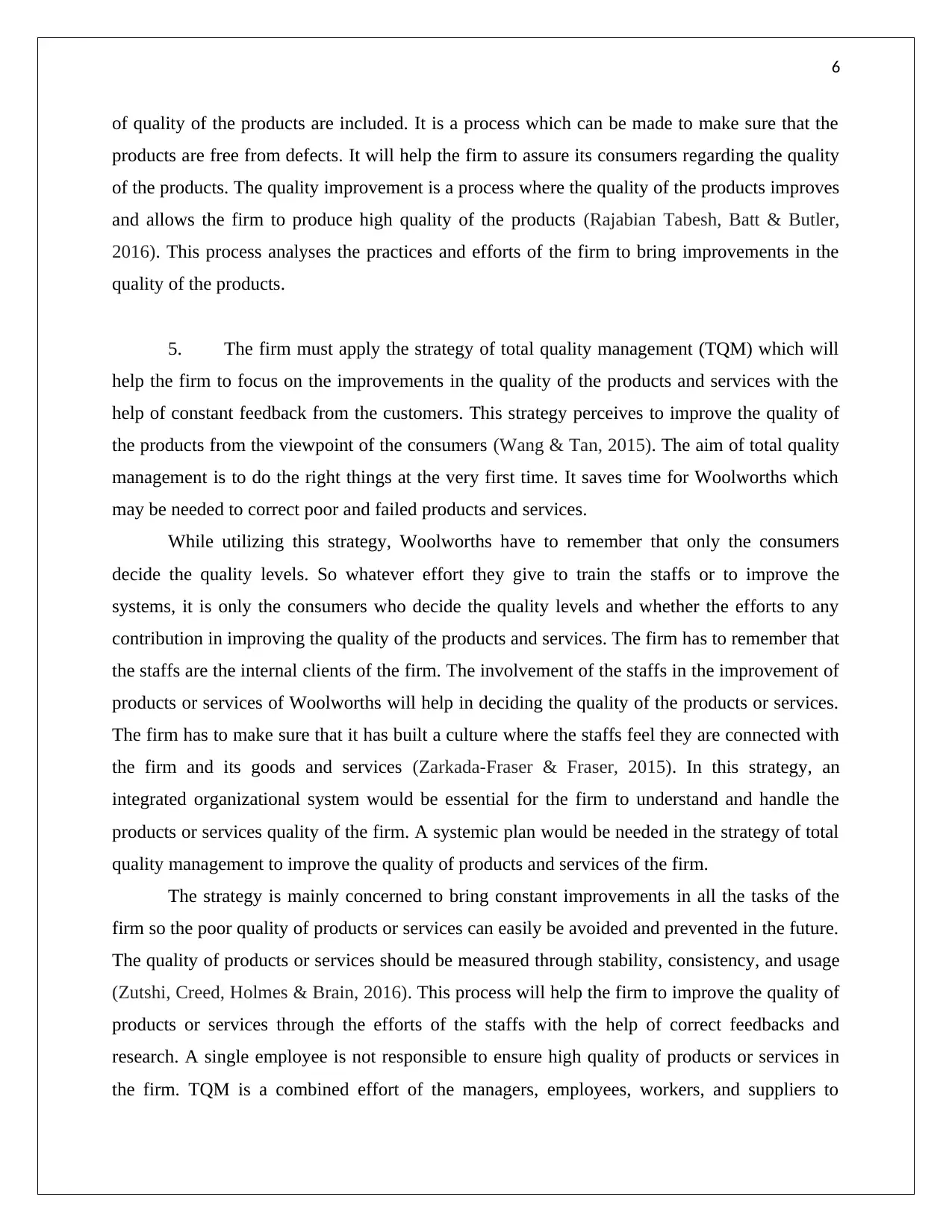
6
of quality of the products are included. It is a process which can be made to make sure that the
products are free from defects. It will help the firm to assure its consumers regarding the quality
of the products. The quality improvement is a process where the quality of the products improves
and allows the firm to produce high quality of the products (Rajabian Tabesh, Batt & Butler,
2016). This process analyses the practices and efforts of the firm to bring improvements in the
quality of the products.
5. The firm must apply the strategy of total quality management (TQM) which will
help the firm to focus on the improvements in the quality of the products and services with the
help of constant feedback from the customers. This strategy perceives to improve the quality of
the products from the viewpoint of the consumers (Wang & Tan, 2015). The aim of total quality
management is to do the right things at the very first time. It saves time for Woolworths which
may be needed to correct poor and failed products and services.
While utilizing this strategy, Woolworths have to remember that only the consumers
decide the quality levels. So whatever effort they give to train the staffs or to improve the
systems, it is only the consumers who decide the quality levels and whether the efforts to any
contribution in improving the quality of the products and services. The firm has to remember that
the staffs are the internal clients of the firm. The involvement of the staffs in the improvement of
products or services of Woolworths will help in deciding the quality of the products or services.
The firm has to make sure that it has built a culture where the staffs feel they are connected with
the firm and its goods and services (Zarkada-Fraser & Fraser, 2015). In this strategy, an
integrated organizational system would be essential for the firm to understand and handle the
products or services quality of the firm. A systemic plan would be needed in the strategy of total
quality management to improve the quality of products and services of the firm.
The strategy is mainly concerned to bring constant improvements in all the tasks of the
firm so the poor quality of products or services can easily be avoided and prevented in the future.
The quality of products or services should be measured through stability, consistency, and usage
(Zutshi, Creed, Holmes & Brain, 2016). This process will help the firm to improve the quality of
products or services through the efforts of the staffs with the help of correct feedbacks and
research. A single employee is not responsible to ensure high quality of products or services in
the firm. TQM is a combined effort of the managers, employees, workers, and suppliers to
of quality of the products are included. It is a process which can be made to make sure that the
products are free from defects. It will help the firm to assure its consumers regarding the quality
of the products. The quality improvement is a process where the quality of the products improves
and allows the firm to produce high quality of the products (Rajabian Tabesh, Batt & Butler,
2016). This process analyses the practices and efforts of the firm to bring improvements in the
quality of the products.
5. The firm must apply the strategy of total quality management (TQM) which will
help the firm to focus on the improvements in the quality of the products and services with the
help of constant feedback from the customers. This strategy perceives to improve the quality of
the products from the viewpoint of the consumers (Wang & Tan, 2015). The aim of total quality
management is to do the right things at the very first time. It saves time for Woolworths which
may be needed to correct poor and failed products and services.
While utilizing this strategy, Woolworths have to remember that only the consumers
decide the quality levels. So whatever effort they give to train the staffs or to improve the
systems, it is only the consumers who decide the quality levels and whether the efforts to any
contribution in improving the quality of the products and services. The firm has to remember that
the staffs are the internal clients of the firm. The involvement of the staffs in the improvement of
products or services of Woolworths will help in deciding the quality of the products or services.
The firm has to make sure that it has built a culture where the staffs feel they are connected with
the firm and its goods and services (Zarkada-Fraser & Fraser, 2015). In this strategy, an
integrated organizational system would be essential for the firm to understand and handle the
products or services quality of the firm. A systemic plan would be needed in the strategy of total
quality management to improve the quality of products and services of the firm.
The strategy is mainly concerned to bring constant improvements in all the tasks of the
firm so the poor quality of products or services can easily be avoided and prevented in the future.
The quality of products or services should be measured through stability, consistency, and usage
(Zutshi, Creed, Holmes & Brain, 2016). This process will help the firm to improve the quality of
products or services through the efforts of the staffs with the help of correct feedbacks and
research. A single employee is not responsible to ensure high quality of products or services in
the firm. TQM is a combined effort of the managers, employees, workers, and suppliers to
Paraphrase This Document
Need a fresh take? Get an instant paraphrase of this document with our AI Paraphraser
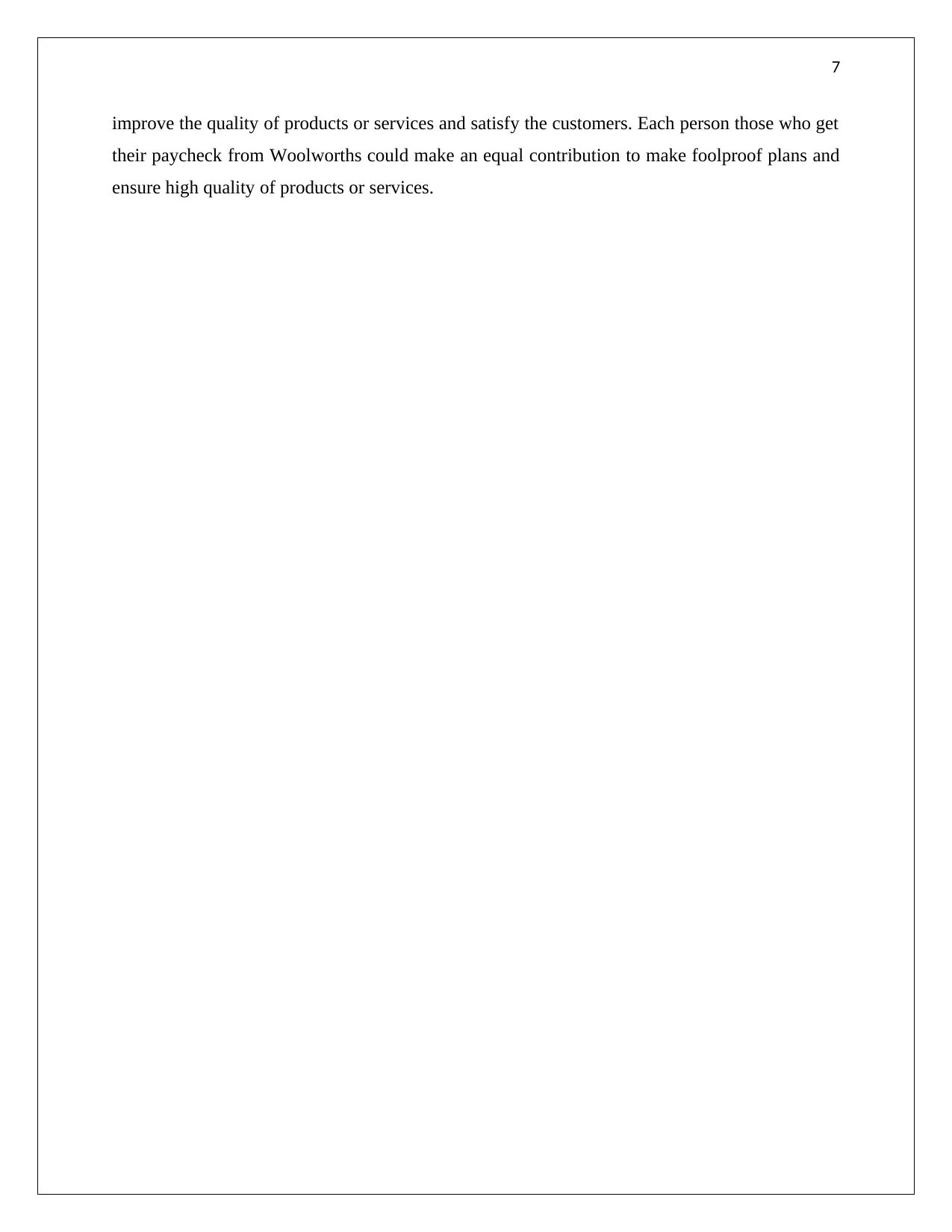
7
improve the quality of products or services and satisfy the customers. Each person those who get
their paycheck from Woolworths could make an equal contribution to make foolproof plans and
ensure high quality of products or services.
improve the quality of products or services and satisfy the customers. Each person those who get
their paycheck from Woolworths could make an equal contribution to make foolproof plans and
ensure high quality of products or services.
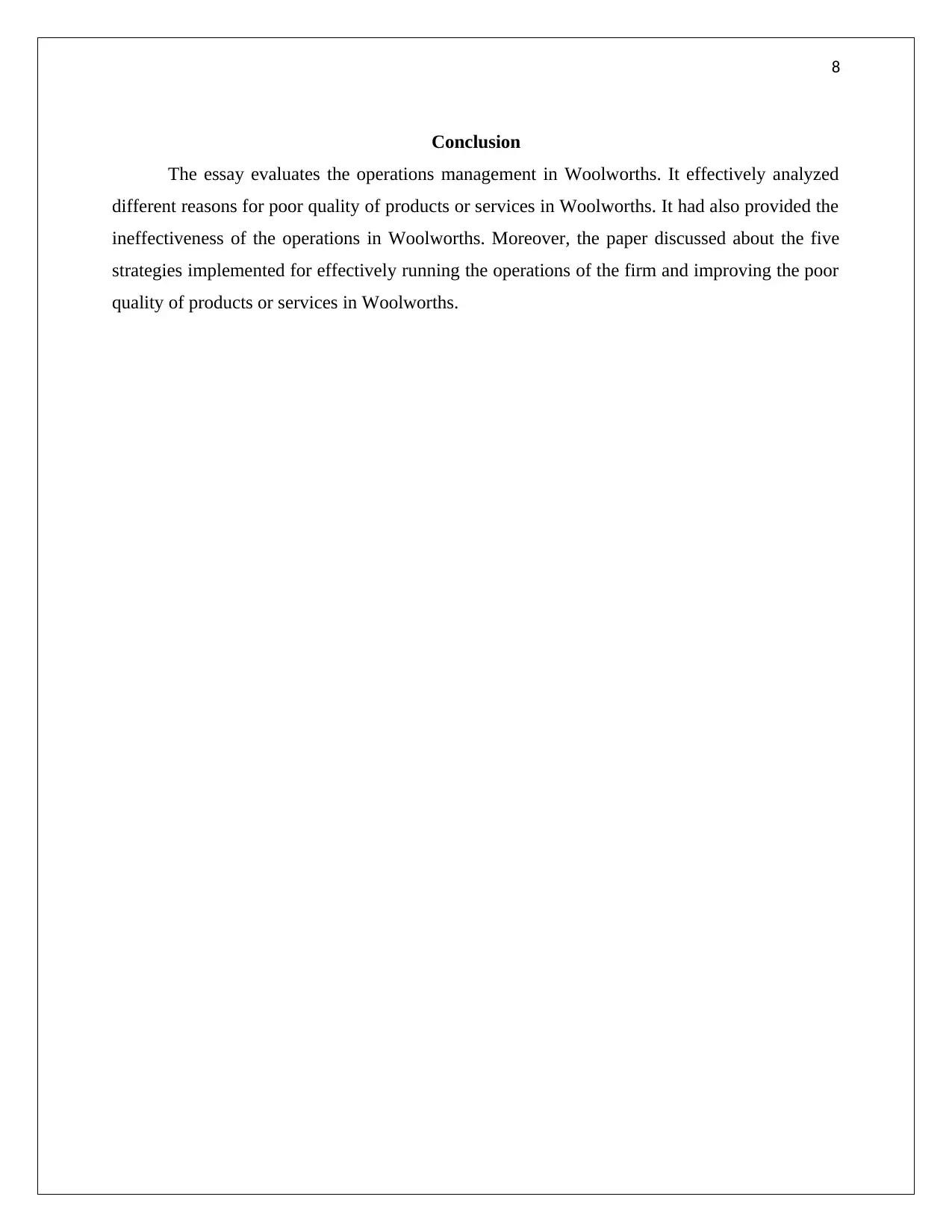
8
Conclusion
The essay evaluates the operations management in Woolworths. It effectively analyzed
different reasons for poor quality of products or services in Woolworths. It had also provided the
ineffectiveness of the operations in Woolworths. Moreover, the paper discussed about the five
strategies implemented for effectively running the operations of the firm and improving the poor
quality of products or services in Woolworths.
Conclusion
The essay evaluates the operations management in Woolworths. It effectively analyzed
different reasons for poor quality of products or services in Woolworths. It had also provided the
ineffectiveness of the operations in Woolworths. Moreover, the paper discussed about the five
strategies implemented for effectively running the operations of the firm and improving the poor
quality of products or services in Woolworths.
⊘ This is a preview!⊘
Do you want full access?
Subscribe today to unlock all pages.

Trusted by 1+ million students worldwide
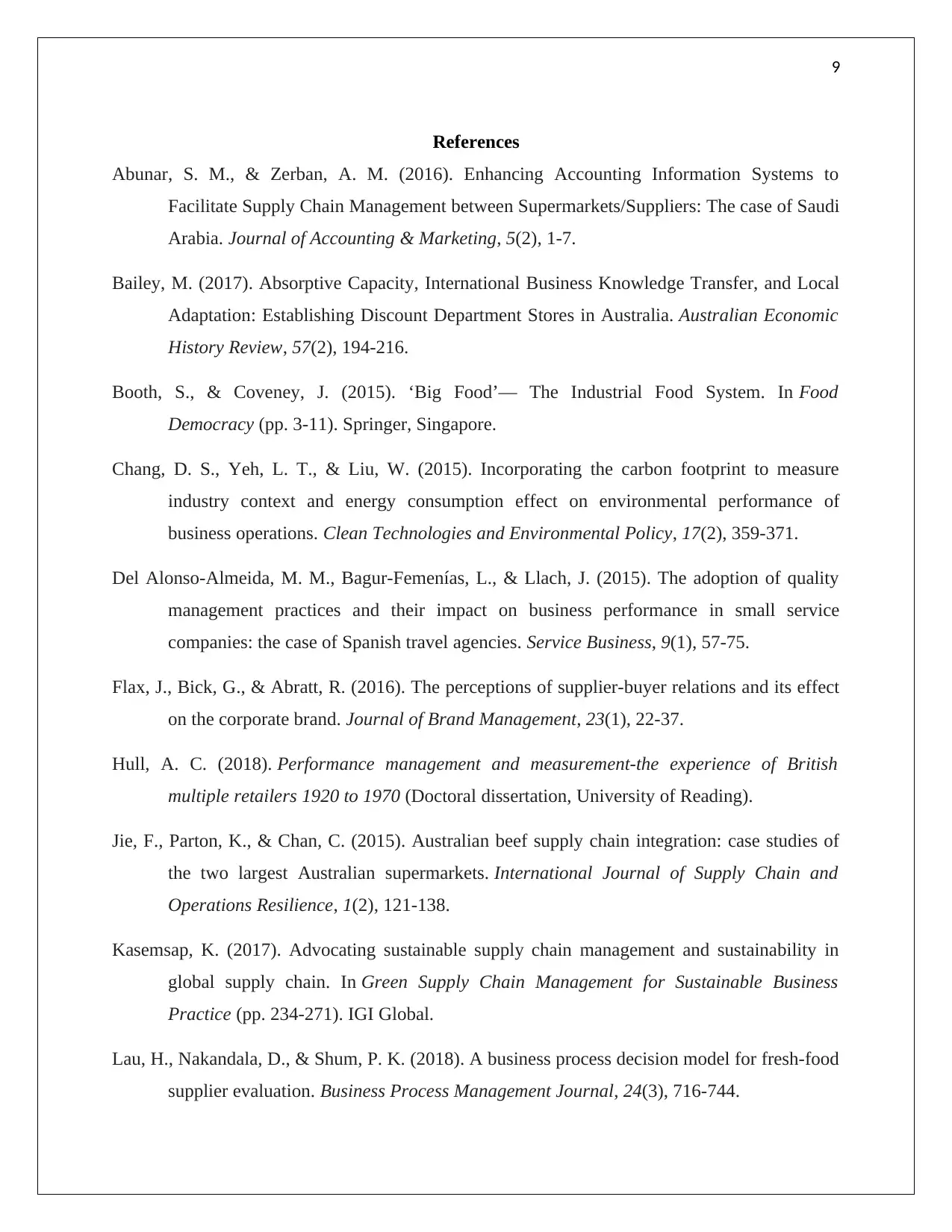
9
References
Abunar, S. M., & Zerban, A. M. (2016). Enhancing Accounting Information Systems to
Facilitate Supply Chain Management between Supermarkets/Suppliers: The case of Saudi
Arabia. Journal of Accounting & Marketing, 5(2), 1-7.
Bailey, M. (2017). Absorptive Capacity, International Business Knowledge Transfer, and Local
Adaptation: Establishing Discount Department Stores in Australia. Australian Economic
History Review, 57(2), 194-216.
Booth, S., & Coveney, J. (2015). ‘Big Food’— The Industrial Food System. In Food
Democracy (pp. 3-11). Springer, Singapore.
Chang, D. S., Yeh, L. T., & Liu, W. (2015). Incorporating the carbon footprint to measure
industry context and energy consumption effect on environmental performance of
business operations. Clean Technologies and Environmental Policy, 17(2), 359-371.
Del Alonso-Almeida, M. M., Bagur-Femenías, L., & Llach, J. (2015). The adoption of quality
management practices and their impact on business performance in small service
companies: the case of Spanish travel agencies. Service Business, 9(1), 57-75.
Flax, J., Bick, G., & Abratt, R. (2016). The perceptions of supplier-buyer relations and its effect
on the corporate brand. Journal of Brand Management, 23(1), 22-37.
Hull, A. C. (2018). Performance management and measurement-the experience of British
multiple retailers 1920 to 1970 (Doctoral dissertation, University of Reading).
Jie, F., Parton, K., & Chan, C. (2015). Australian beef supply chain integration: case studies of
the two largest Australian supermarkets. International Journal of Supply Chain and
Operations Resilience, 1(2), 121-138.
Kasemsap, K. (2017). Advocating sustainable supply chain management and sustainability in
global supply chain. In Green Supply Chain Management for Sustainable Business
Practice (pp. 234-271). IGI Global.
Lau, H., Nakandala, D., & Shum, P. K. (2018). A business process decision model for fresh-food
supplier evaluation. Business Process Management Journal, 24(3), 716-744.
References
Abunar, S. M., & Zerban, A. M. (2016). Enhancing Accounting Information Systems to
Facilitate Supply Chain Management between Supermarkets/Suppliers: The case of Saudi
Arabia. Journal of Accounting & Marketing, 5(2), 1-7.
Bailey, M. (2017). Absorptive Capacity, International Business Knowledge Transfer, and Local
Adaptation: Establishing Discount Department Stores in Australia. Australian Economic
History Review, 57(2), 194-216.
Booth, S., & Coveney, J. (2015). ‘Big Food’— The Industrial Food System. In Food
Democracy (pp. 3-11). Springer, Singapore.
Chang, D. S., Yeh, L. T., & Liu, W. (2015). Incorporating the carbon footprint to measure
industry context and energy consumption effect on environmental performance of
business operations. Clean Technologies and Environmental Policy, 17(2), 359-371.
Del Alonso-Almeida, M. M., Bagur-Femenías, L., & Llach, J. (2015). The adoption of quality
management practices and their impact on business performance in small service
companies: the case of Spanish travel agencies. Service Business, 9(1), 57-75.
Flax, J., Bick, G., & Abratt, R. (2016). The perceptions of supplier-buyer relations and its effect
on the corporate brand. Journal of Brand Management, 23(1), 22-37.
Hull, A. C. (2018). Performance management and measurement-the experience of British
multiple retailers 1920 to 1970 (Doctoral dissertation, University of Reading).
Jie, F., Parton, K., & Chan, C. (2015). Australian beef supply chain integration: case studies of
the two largest Australian supermarkets. International Journal of Supply Chain and
Operations Resilience, 1(2), 121-138.
Kasemsap, K. (2017). Advocating sustainable supply chain management and sustainability in
global supply chain. In Green Supply Chain Management for Sustainable Business
Practice (pp. 234-271). IGI Global.
Lau, H., Nakandala, D., & Shum, P. K. (2018). A business process decision model for fresh-food
supplier evaluation. Business Process Management Journal, 24(3), 716-744.
Paraphrase This Document
Need a fresh take? Get an instant paraphrase of this document with our AI Paraphraser
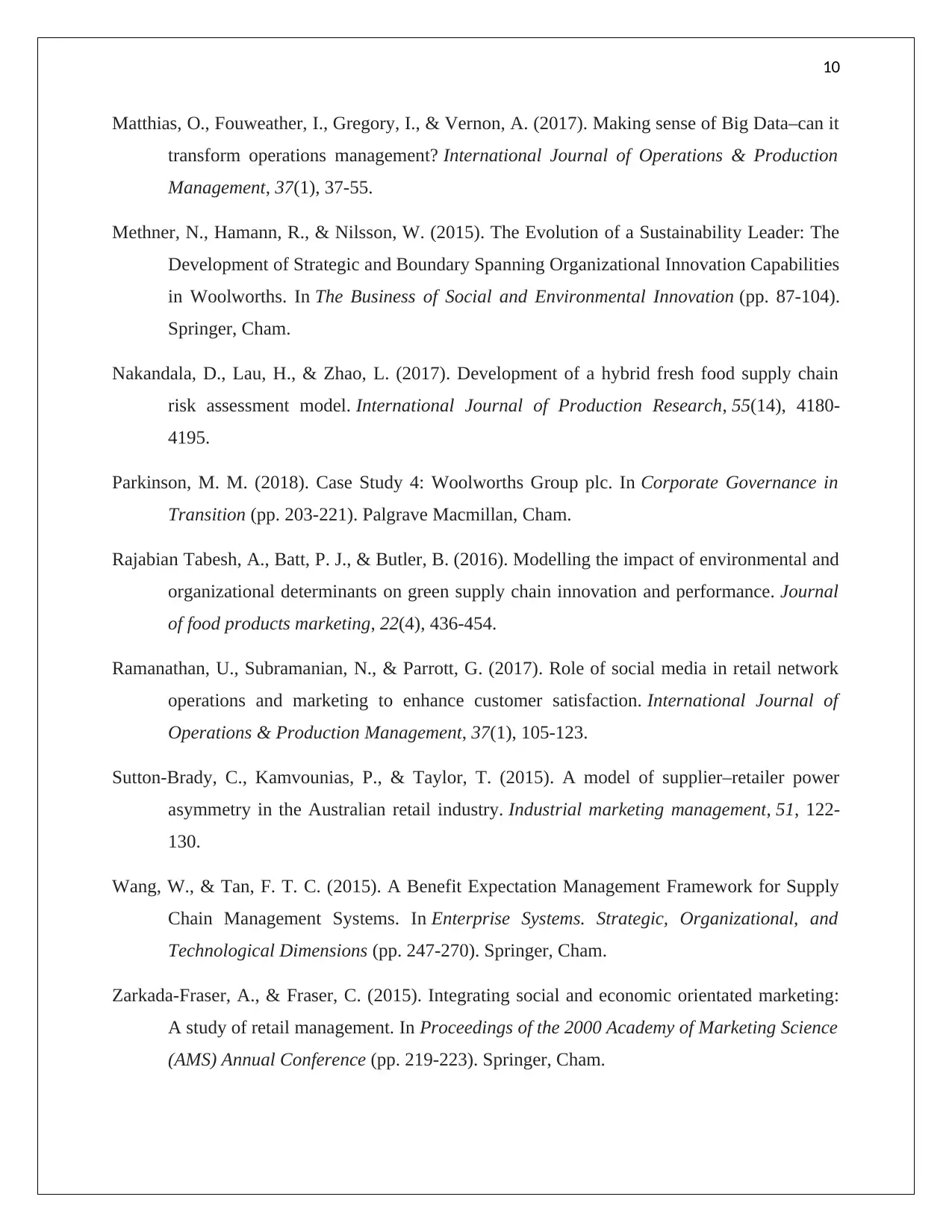
10
Matthias, O., Fouweather, I., Gregory, I., & Vernon, A. (2017). Making sense of Big Data–can it
transform operations management? International Journal of Operations & Production
Management, 37(1), 37-55.
Methner, N., Hamann, R., & Nilsson, W. (2015). The Evolution of a Sustainability Leader: The
Development of Strategic and Boundary Spanning Organizational Innovation Capabilities
in Woolworths. In The Business of Social and Environmental Innovation (pp. 87-104).
Springer, Cham.
Nakandala, D., Lau, H., & Zhao, L. (2017). Development of a hybrid fresh food supply chain
risk assessment model. International Journal of Production Research, 55(14), 4180-
4195.
Parkinson, M. M. (2018). Case Study 4: Woolworths Group plc. In Corporate Governance in
Transition (pp. 203-221). Palgrave Macmillan, Cham.
Rajabian Tabesh, A., Batt, P. J., & Butler, B. (2016). Modelling the impact of environmental and
organizational determinants on green supply chain innovation and performance. Journal
of food products marketing, 22(4), 436-454.
Ramanathan, U., Subramanian, N., & Parrott, G. (2017). Role of social media in retail network
operations and marketing to enhance customer satisfaction. International Journal of
Operations & Production Management, 37(1), 105-123.
Sutton-Brady, C., Kamvounias, P., & Taylor, T. (2015). A model of supplier–retailer power
asymmetry in the Australian retail industry. Industrial marketing management, 51, 122-
130.
Wang, W., & Tan, F. T. C. (2015). A Benefit Expectation Management Framework for Supply
Chain Management Systems. In Enterprise Systems. Strategic, Organizational, and
Technological Dimensions (pp. 247-270). Springer, Cham.
Zarkada-Fraser, A., & Fraser, C. (2015). Integrating social and economic orientated marketing:
A study of retail management. In Proceedings of the 2000 Academy of Marketing Science
(AMS) Annual Conference (pp. 219-223). Springer, Cham.
Matthias, O., Fouweather, I., Gregory, I., & Vernon, A. (2017). Making sense of Big Data–can it
transform operations management? International Journal of Operations & Production
Management, 37(1), 37-55.
Methner, N., Hamann, R., & Nilsson, W. (2015). The Evolution of a Sustainability Leader: The
Development of Strategic and Boundary Spanning Organizational Innovation Capabilities
in Woolworths. In The Business of Social and Environmental Innovation (pp. 87-104).
Springer, Cham.
Nakandala, D., Lau, H., & Zhao, L. (2017). Development of a hybrid fresh food supply chain
risk assessment model. International Journal of Production Research, 55(14), 4180-
4195.
Parkinson, M. M. (2018). Case Study 4: Woolworths Group plc. In Corporate Governance in
Transition (pp. 203-221). Palgrave Macmillan, Cham.
Rajabian Tabesh, A., Batt, P. J., & Butler, B. (2016). Modelling the impact of environmental and
organizational determinants on green supply chain innovation and performance. Journal
of food products marketing, 22(4), 436-454.
Ramanathan, U., Subramanian, N., & Parrott, G. (2017). Role of social media in retail network
operations and marketing to enhance customer satisfaction. International Journal of
Operations & Production Management, 37(1), 105-123.
Sutton-Brady, C., Kamvounias, P., & Taylor, T. (2015). A model of supplier–retailer power
asymmetry in the Australian retail industry. Industrial marketing management, 51, 122-
130.
Wang, W., & Tan, F. T. C. (2015). A Benefit Expectation Management Framework for Supply
Chain Management Systems. In Enterprise Systems. Strategic, Organizational, and
Technological Dimensions (pp. 247-270). Springer, Cham.
Zarkada-Fraser, A., & Fraser, C. (2015). Integrating social and economic orientated marketing:
A study of retail management. In Proceedings of the 2000 Academy of Marketing Science
(AMS) Annual Conference (pp. 219-223). Springer, Cham.
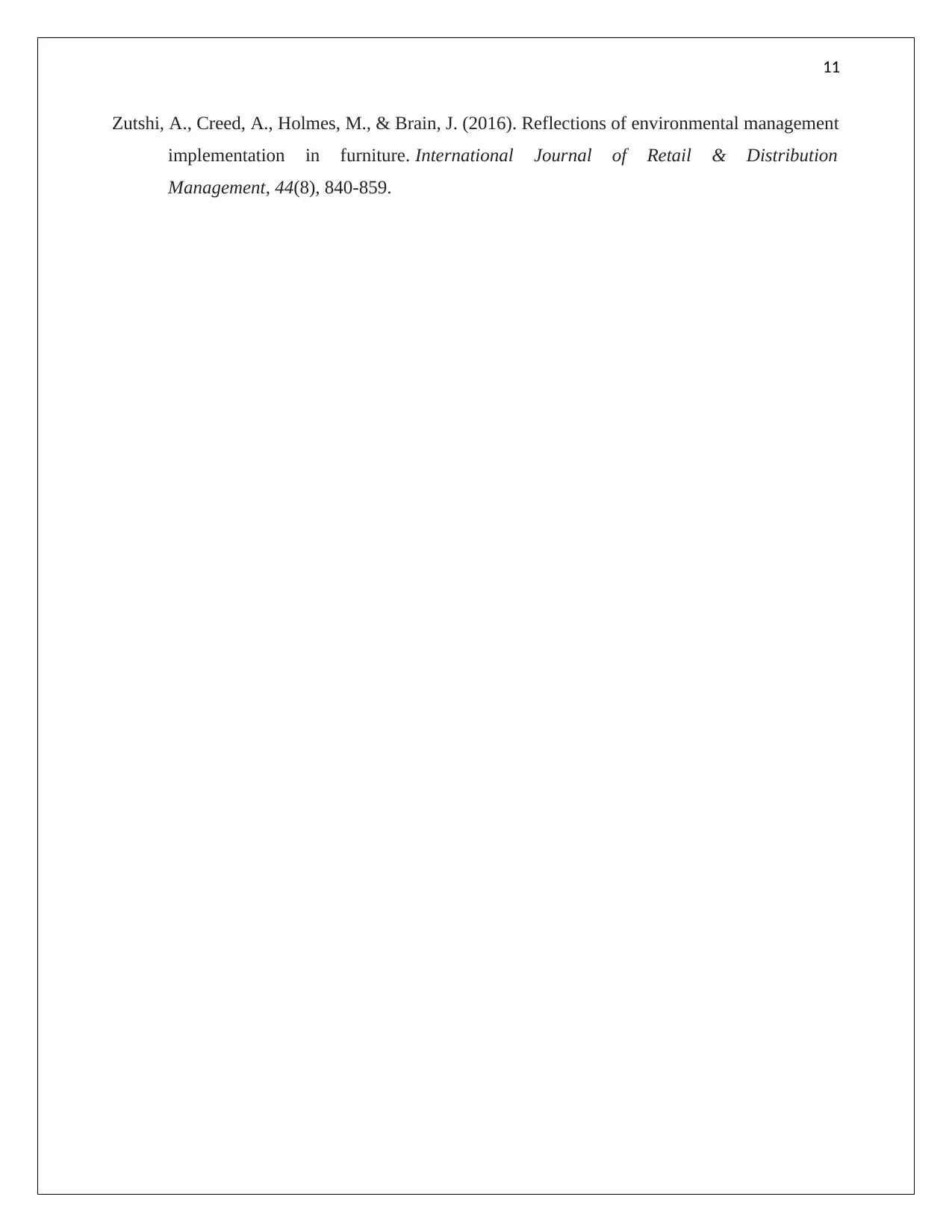
11
Zutshi, A., Creed, A., Holmes, M., & Brain, J. (2016). Reflections of environmental management
implementation in furniture. International Journal of Retail & Distribution
Management, 44(8), 840-859.
Zutshi, A., Creed, A., Holmes, M., & Brain, J. (2016). Reflections of environmental management
implementation in furniture. International Journal of Retail & Distribution
Management, 44(8), 840-859.
⊘ This is a preview!⊘
Do you want full access?
Subscribe today to unlock all pages.

Trusted by 1+ million students worldwide
1 out of 12
Related Documents
Your All-in-One AI-Powered Toolkit for Academic Success.
+13062052269
info@desklib.com
Available 24*7 on WhatsApp / Email
![[object Object]](/_next/static/media/star-bottom.7253800d.svg)
Unlock your academic potential
Copyright © 2020–2025 A2Z Services. All Rights Reserved. Developed and managed by ZUCOL.





